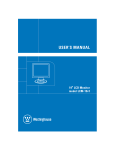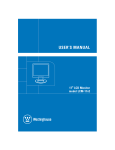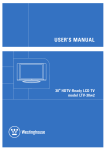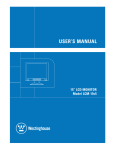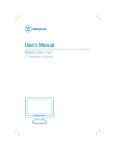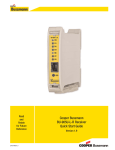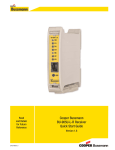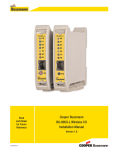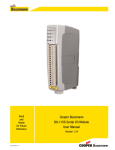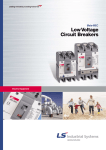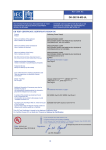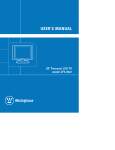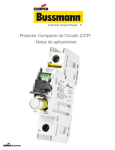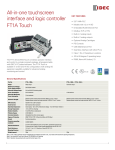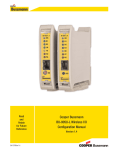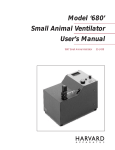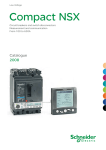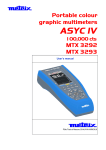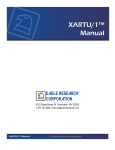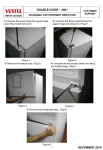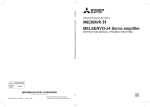Download CCP - Cooper Industries
Transcript
Compact Circuit Protector (CCP) Application Note Application Note Table Of Contents Description Page Objective. . . . . . . . . . . . . . . . . . . . . . . . . . . . . . . . . . . . . . . . . . . . . . . 3 Compact Circuit Protector (CCP). . . . . . . . . . . . . . . . . . . . . . . . . . . . . 4 CCP-Class CC CCP-CubeFuse® CCP-10x38 CCP-DC Accessories General Overcurrent Protection Considerations. . . . . . . . . . . . . . . . . . 5 Comparison - Fusible Solution . . . . . . . . . . . . . . . . . . . . . . . . . . . . . . 5 Comparison - Circuit Breaker Solution. . . . . . . . . . . . . . . . . . . . . . . . . 6 Control Circuit Applications. . . . . . . . . . . . . . . . . . . . . . . . . . . . . . . . . 7 Resistive Heating and Lighting Circuit Applications. . . . . . . . . . . . . . . 8 Comparison - Motor Circuit Solution. . . . . . . . . . . . . . . . . . . . . . . . . . 9 Motor Circuit Applications. . . . . . . . . . . . . . . . . . . . . . . . . . . . . . . . . 10 Comparison - Power Electronic Solution. . . . . . . . . . . . . . . . . . . . . . 11 Power Electronic Applications. . . . . . . . . . . . . . . . . . . . . . . . . . . . . . 12 16AWG and 18AWG Conductors in Industrial Machinery. . . . . . . . . . 13 Global Applications. . . . . . . . . . . . . . . . . . . . . . . . . . . . . . . . . . . . . . 14 DC Applications. . . . . . . . . . . . . . . . . . . . . . . . . . . . . . . . . . . . . . . . .14 Remote Indication Accessories . . . . . . . . . . . . . . . . . . . . . . . . . . . . . 14 Illustrations courtesy of IAEI 2 ©2009 Cooper Bussmann Application Note Objective: Compact Circuit Protector This application note explains the use and application of the Cooper Bussmann® Compact Circuit Protector (CCP) in industrial control applications, such as industrial control panels, industrial machinery and HVAC equipment. The CCP is a disconnect switch that incorporates the benefits of fusible overcurrent protection in the smallest footprint available in the industry. The CCP is available in four different fusible variations: Class CC, Low-Peak® CUBEFuse® (with Class J performance characteristics), 10X38, and DC. There are many possible considerations in the selection of Table 1 – Features and Feature Smaller Simpler Better ©2009 Cooper Bussmann disconnecting means and overcurrent protection for industrial control applications. The most important considerations depend upon the specific application for initial and possible future installations. The CCP offers increased voltage ratings, higher interrupting ratings (IR), enhanced short-circuit current ratings (SCCR), superior protection of circuit components, improved reliability, and flexibility of application, as well as decreased size and cost when compared to equivalently rated alternatives. For industrial control applications, the CCP is the smaller, simpler, better solution as shown in Table 1. Benefits of the CCP Benefit • 1/3 the space (footprint) of equivalent rated circuit breaker • Space-saving design for reduced cost • 2/3 the space (footprint) of equivalent rated traditional fusible disconnects All Versions • DIN-rail mounted • Ease of installation • Local open-fuse indication • Ease of maintenance • Load-break disconnect rated • Lock-out/tag-out provisions • Disconnecting means, isolation of equipment and • Finger-safe - IP20 compliant with enhanced safety 10AWG or larger • DIN 43880 compliant • Device interchangeability for global design capabilities CCP-Class CC or CCP-CUBEFuse • UL 98 Listed and cULus Certified • Suitable for use on main, feeder and branch circuits • HP rated • Use on any low voltage AC system (solidly grounded, • 30A (Class CC version), resistance grounded, corner grounded or ungrounded) 30A or 60A (CUBEFuse version), 600Vac, (straight rated not slash rated) • 200kA IR • Highest possible interrupting rating • Accepts only Class CC fuses or • Rejects fuses with lower voltage and interrupting ratings CUBEFuse • Current-limiting overcurrent protection • Increased component SCCR combination ratings • Meets NFPA 79 and UL 508A • Reduced wiring costs for NPFA 79 and UL 508A industrial requirements for utilization of 16AWG machinery applications and 18AWG conductors CCP-10x38 • 30A, 250Vac or less (voltage and IR varies with installed midget fuse) • UL 508 Listed and cULus • 32A, 600Vac or less, (voltage and IR • Flexibility of use for IEC applications or UL supplemental varies with installed 10x38 IEC fuse) protection applications • IEC 60947-3 AC23A with 32A aM or 25A gG IEC fuse CCP-DC • 80Vdc or less, (voltage and IR • Low-cost DC rated disconnect with overcurrent protection varies with installed fuse rating) • UL 98 Listed and cULus Certified • Branch Circuit overcurrent protection available with (Class CC version), 20kA IR Class CC version • Higher ratings: voltage, interrupting • Ease of design, flexibility of use and reduced misapplications rating and SCCR • Increased component protection • Enhanced safety and equipment SCCR • Reliability of overcurrent protection • Maintenance is not required for fuses • Accessories – auxiliary contacts and • Instant remote communication (switch and fuse status) open-fuse indication options 3 Application Note Compact Circuit Protector - Product Overview & Accessories CCP-Class CC (AC applications) CCP-CUBEFuse (AC applications) Catalog number: CCP-1-30CC (1-Pole), CCP-2-30CC (2-Pole), CCP-3-30CC (3-Pole) Recommended Fuses: LP-CC, KTK-R or FNQ-R Catalog number: 30A maximum CCP-1-30CF (1-Pole), CCP-2-30CF (2-Pole), CCP-3-30CF (3-Pole) Recommended Fuses: TCF (indicating) 60A maximum CCP-1-60CF (1-Pole), CCP-2-60CF (2-Pole), CCP-3-60CF (3-Pole) TCF_RN (non-indicating) Catalog number: CCP-1-30M (1-Pole), CCP-2-30M (2-Pole), CCP-3-30M (3-Pole) Recommended Fuses: KTK, FNQ, FNM, C10G or C10M Catalog number: CCP-1-DCC (Class CC fuse, 1-pole) Catalog number: CCP-1-DCM (Midget fuse, 1-pole) CCP-10x38 (AC applications) CCP-DC (DC applications) Recommended Fuse: LP-CC Recommended Fuse: KLM Accessories 4 Catalog number: CCP-PLC-IND Catalog number: CCP-AUX Catalog number: ICM-DIN Wired remote fuse indication for PLC applications Auxiliary contacts NO+NC for switch status Intelligent circuit monitor for Cooper InVision™ Downtime Reduction System ©2009 Cooper Bussmann Application Note General Overcurrent Protection Considerations: or J fuse holders with the added benefit of providing a disconnecting means. It can be used to replace a UL 508 disconnect (marked manual motor controller) combined with fuses providing a motor circuit disconnect. Compared to existing Class CC or J fusible UL 98 disconnects, the CCP has the same ratings and capabilities but with smaller size and lower cost. Table 2 illustrates the size and application comparison of fusible overcurrent devices. Red Italic text indicates limitations of devices. The CCP provides a simple, compact, cost-effective solution with reliable overcurrent protection and load-break disconnect capabilities not possible with existing fuseholders, fusible switches or mechanical overcurrent devices. Comparison – Fusible Solutions: The CCP is very versatile since it is the smallest, most cost effective UL 98 branch circuit disconnect with branch circuit rated overcurrent protection. The CCP can replace Class CC Table 2 – CCP Compared to Fuse Holder, Disconnect with Fuses, and Fusible Disconnect UL 98 Listed CCP with Class CC Fuses or CUBEFuse® UL 508 UL 4248 Listed UL 4248 Listed Listed Class CC Fuse Class CC Fuse Disconnect Holder with Holder with (Manual UL 98 Listed UL 98 Listed Class CC Class CC Fuses Motor Disconnect with Class CC Fuses or and UL 508 Listed Controller) UL 4248 Listed Fusible CUBEFuse Disconnect with Integral Class CC Fuse Disconnect with with (Manual Motor Class CC Holder with Class CC Fuse Holder Controller) Fuses Class CC Fuses or J Fuses Relative Size Comparison Branch Circuit Overcurrent Protection Branch Circuit Disconnect Motor Circuit Disconnect Feeder Circuit Overcurrent Protection Feeder Circuit Disconnect Cost Yes Yes Yes Yes Yes Yes Yes No No No Yes Yes Yes No Yes* Yes* Yes Yes Yes Yes N/A** N/A** Yes Yes Yes No No No Yes Yes $$-$$$ $-$$ $$$*** $$$ $$$$*** $$$$$ *Manual motor controller must be additionally marked “Suitable as Motor Disconnect” and be installed on the loadside of the final Branch Circuit overcurrent protective device ** Class CC fuse can provide feeder circuit overcurrent protection but UL 508 manual motor controller cannot be applied in a feeder circuit ***CUBEFuse with fuse holder could be used in place of Class CC fuse holder with Class CC fuses at additional cost ©2009 Cooper Bussmann 5 Application Note Comparison - Circuit Breaker Solutions: The CCP can replace low rated circuit breakers or misapplied supplementary protectors in branch circuit applications and provide a higher short-circuit current rating at a similar or lower cost. The CCP is a cost-effective solution similar in size to a supplementary protector or lighting style circuit breaker, but with higher voltage ratings and higher interrupting ratings while providing better current-limiting overcurrent protection. Compared to an equivalently rated industrial circuit breaker, the CCP is onethird the size. Table 3 shows the size and rating differences between the CCP and a supplementary protector, lighting circuit breaker (240V, 480/277V or 600/347V) and fully rated (600V) industrial circuit breaker. Red Italic text indicates devices limitations. Table 3 – CCP Compared to Supplementary Protector, Lighting Circuit Breakers, and Fully Rated Industrial Circuit Breakers UL 98 Listed CCP with Class CC Fuses or CUBEFuse® UL 1077 Recognized Supplementary Protector UL 489 Listed Circuit Breaker UL 489 Listed Circuit Breaker UL 489 Listed Circuit Breaker Yes No Yes Yes Yes Yes No Yes Yes Yes Voltage Rating (AC) 600V Typically 277V or less Typically 240V or less Typically 480/277V or 600/347V† Typically 600V or less Interrupting Rating 200kA Typically 5-10kA Typically 10-14kA Typically 14kA-18kA Varies 14kA -100kA* Overcurrent Protection Method Cost Class CC fuse or CUBEFuse $$-$$$ Thermal magnetic trip $ Thermal magnetic trip $$ Thermal magnetic trip $$$ Thermal magnetic trip $$$$ Relative Size Comparison Branch or Feeder Circuit Overcurrent Protection Branch or Feeder Circuit Disconnect *Cost increases as interrupting rating increases †Limits application to solidly grounded wye systems only, not permitted on ungrounded, resistance grounded or corner grounded systems 6 ©2009 Cooper Bussmann Application Note Control Circuit Applications: When control circuit transformers or power supplies are tapped from the feeder circuit, UL 508A requires protection of the control circuit by a branch circuit overcurrent device. When tapped from the branch circuit, only supplemental overcurrent protection is required. However, in both cases, the equipment SCCR cannot be higher than the interrupting rating of the control circuit overcurrent device. The CCP can be used in these applications to provide costeffective overcurrent protection, high interrupting rating and increased equipment SCCR. Where supplemental protectors and standard circuit breakers are used, the voltage rating and interrupting rating limits the application of equipment unless more expensive circuit breakers with higher ratings are used. Table 4 compares the CCP with supplemental protectors and circuit breakers for these applications. Table 4 – CCP Compared to Circuit Breakers in Protection of Control Circuits Control Circuit Tapped from Branch Circuit Equipment SCCR = 200kA Equipment SCCR = 5kA Supplemental overcurrent device permitted but may lower SCCR Motor branch circuit overcurrent device Motor branch circuit overcurrent device For higher SCCR utilize 200kA CCP-Class CC or CCP-CUBEFuse® Power supply or control transformer Motor Motor Supplemental overcurrent device permitted 5kA Supplementary protector Power supply or control transformer Control Circuit Tapped from Feeder Circuit Equipment SCCR = 200kA Equipment SCCR = 14kA - 100kA* Feeder overcurrent device Feeder overcurrent device Branch circuit overcurrent device Motor Branch circuit overcurrent device required 200kA CCP-Class CC or CCP-CUBEFuse® Power supply or control transformer Branch circuit overcurrent device Motor Branch circuit overcurrent device required 14kA Circuit breaker Power supply or control transformer Note: Power supplies must be listed for use with the overcurrent device selected. A manual motor protector cannot be used for overcurrent protection of power supplies tapped from the feeder circuit or the branch circuit. *Cost increases with higher interrupting rating ©2009 Cooper Bussmann 7 Application Note Resistive Heating and Lighting Circuit Applications: Branch circuit overcurrent devices are required for protection of resistive heating and lighting circuits. Low rated circuit breakers or misapplied supplementary protectors are sometimes used in these applications. Although the voltage and interrupting rating of the circuit breaker can be increased (resulting in increased cost), other circuit components, such as magnetic contactors, may have low short-circuit current ratings when protected by circuit breakers. The low interrupting ratings or low component SCCR will limit the equipment SCCR. As shown in Table 5, with circuit breaker protection, the equipment is limited to an SCCR of 5kA due to the 5kA SCCR rating of the magnetic contactor when protected by a circuit breaker. The CCP is a cost-effective solution that does not limit the SCCR and can be used to raise the SCCR of components such as a magnetic contactor. Therefore, it is easier to achieve higher equipment SCCR utilizing the CCP. Table 5 – CCP Compared to Circuit Breakers in Protection of Heating/Lighting Circuits Equipment SCCR = 100kA 200kA CCP- Class CC ® or CCP-CUBEFuse Magnetic contactor (100kA SCCR with Class CC or J fuse) 14kA Circuit breaker Heating/ Lighting loads Common Misapplications in Branch Circuits Misuse of IEC Protective Devices and Disconnects Sometime equipment designed and assembled to IEC electrical system and equipment standards (intended for installation in countries using the IEC electrical safety system) is shipped to the United States. This equipment may not meet the North American electrical safety system requirements, which includes the National Electrical Code®, North American product standards/certifications, such as to UL, and local installation codes/inspection by the authority having jurisdiction (AHJ). For such equipment, it is common to have IEC overcurrent protective devices protecting branch circuits. This can create issues since these IEC devices are typically not rated for overcurrent protection of branch circuits for North American electrical systems and equipment. However, if the equipment is installed in the United States, all branch circuits must be protected by UL Listed branch circuit overcurrent devices and disconnects suitably rated for the application. The CCP can be used to retrofit IEC overcurrent protection and disconnect devices in equipment for proper 8 Equipment SCCR = 5kA Magnetic contactor (5kA SCCR with circuit breaker) Heating/ Lighting loads installation in the United States. If done, the sizing of the CCP and overcurrent protection should be per the NEC® (National Electrical Code) and other applicable codes and standards. Misuse of Manual Motor Starters and Self-Protected Starters Manual motor starters (also known as Manual Motor Protectors or MMP), are permitted to provide overload protection for motor circuits. Self-protected starters (SPS) are permitted to provide overload and short-circuit protection for motor branch circuits. However, it is not uncommon to see these devices misapplied as protection of non-motor loads and even feeder circuits. Manual motor protectors and self-protected starters can never be used for branch circuit overcurrent protection of non-motor loads such as resistive heating, lighting, power supplies, or general-purpose circuits. Also, these devices can not be used for feeder circuit protection. The CCP can replace misapplied manual motor protectors and self-protected starters in non-motor applications. ©2009 Cooper Bussmann Application Note Motor Circuit Solution Comparison: The CCP with a magnetic starter is a cost-effective, compact solution for motor circuits. Table 6 is a size and application comparison of the CCP with a magnetic starter compared to fuse and fuseholder with a magnetic starter, self-protected starter with a magnetic contactor, fuse and fuseholder with a manual motor protector and magnetic contactor, instantaneous-trip circuit breaker (also known as motor circuit protector or MCP) with magnetic starter, and inverse-time circuit breaker with magnetic starter. Red italic text indicates limitations of devices. Table 6 – CCP and Magnetic Starter Compared to Other Motor Circuit Protective Devices UL 4248 Listed Class CC Fuse Holder with UL 98 Class CC Fuses Listed CCP or with Class CC CUBEFuse Fuses or with Fuse Holder CUBEFuse® and and Magnetic Magnetic Starter Starter Branch Circuit Overcurrent Protection Motor Circuit Disconnect UL 489 Recognized Motor Circuit Protector (MCP) and Magnetic Starter** UL 489 Listed Circuit Breaker and Magnetic Starter Yes Yes Yes††† Yes Yes** Yes Yes No Yes Yes* Yes** Yes Typically 480V or 600V Typically 600V Typically 600V Typically 30kA or 65kA†† Varies 14kA to 100kA*** Varies 14kA to 100kA*** Typically 480/277V† or 600/347V† Typically 30kA or 65kA†† Voltage Rating 600V 600V SCCR Typically 100kA Typically 100kA Yes Yes No No No No $$-$$$ $-$$ $-$$ $$$-$$$$ $$$$ $$$$$ High SCCR with Multiple Manufacturers Cost * ** *** † †† ††† UL 508 Listed SelfProtected Starter (SPS) and Magnetic Contactor UL 4248 Listed Class CC Fuse Holder with Class CC Fuses or CUBEFuse with Fuse Holder and Manual Motor Protector (MMP) and Magnetic Contactor If on loadside of the final Branch Circuit overcurrent device and MMP is marked “Suitable as Motor Disconnect” Must be part of a listed combination, typically from same manufacturer Cost increases as interrupting rating increases Limits application to solidly grounded wye systems only, not permitted on ungrounded, resistance grounded or corner grounded systems SCCR is lower at higher voltage rating May require additional accessories such as line side terminals, to be used as a self-protected starter ©2009 Cooper Bussmann 9 Application Note Motor Circuit Applications: In motor circuit applications, several important considerations must be analyzed to determine the best solution for the specific application. The first consideration is the ability to disconnect, isolate and lockout/tagout the motor for maintenance and enhanced safety. Other important considerations to assure flexibility of design and applications for motor circuits are: • Increased interrupting ratings and short-circuit current ratings • Increased voltage ratings • Ratings with variety of components and manufacturers Table 7 compares the three most common motor circuit alternatives that provide disconnection, isolation and lockout/tagout capabilities and the effect on the other important considerations. Table 7 – CCP and Magnetic Starter Compared with Other Motor Circuit Protective Devices CCP with Magnetic Starter – Equipment SCCR = 100kA 200kA CCP -Class CC or CCP-CUBEFuse® • The CCP-Class CC or CCP-CUBEFuse® (with Class J performance characteristics) and magnetic starter can achieve a high SCCR (100kA) at a full voltage rating (600V) with many magnetic starter manufacturers in a smaller footprint. Magnetic starter (100kA SCCR with Class CC or J fuse) Motor Self-Protected Starter with Contactor – Equipment SCCR = 5kA-65kA • Self-protected starters generally have a relatively high SCCR but the corresponding voltage rating is typically slash rated (480/277V). Slash rated devices (480/277V) cannot be used on 480V (or higher) ungrounded, corner grounded or resistance grounded systems (which are becoming more common). • If a magnetic contactor from a different manufacturer is utilized, the magnetic contactor will limit the equipment SCCR, since devices from different manufacturers have not typically been tested above the standard short-circuit current rating (5kA). Similarly, some manufacturers have not tested magnetic contactors with self-protected starters at higher short-circuit current ratings. 65kA 480Y/277V Self-protected starter Different manufacturers magnetic contactor (5kA SCCR with SPS) Motor Circuit Breaker or MCP with Magnetic Starter – Equipment SCCR = 5kA-100kA • Circuit breakers and magnetic starters can be used, but the SCCR ratings will be limited (typically 5kA) if the magnetic starter is from a different manufacturer than the circuit breaker. • MCPs and magnetic starters can be used only if part of a listed combination (typically must be from the same manufacturer). • Circuit breakers and MCPs can have a high SCCR if a high interrupting rating circuit breaker or MCP is selected for use with a magnetic starter from the same manufacturer. However, this can greatly increase the cost, and locks the user into only one manufacturer. 10 14kA Circuit breaker Different manufacturers magnetic starter (5kA SCCR with circuit breaker) Motor ©2009 Cooper Bussmann Application Note Power Electronics Solution Comparison: The CCP with a drive is a cost-effective, compact solution for protection of power electronic devices, such as variable frequency drives (VFD). Table 8 is a size and application comparison of the CCP with a drive compared to fuse and fuse holder with a drive, self-protected starter with a drive, MCP with a drive, and a circuit breaker with a drive. Red Italic text indicates limitations of devices. Table 8 – CCP and Drive Compared with Other Overcurrent Protective Devices and Drives UL 98 Listed CCP-Class CC or CCP-CUBEFuse® and VFD UL 4248 Listed Class CC Fuse Holder with Class CC Fuses or CUBEFuse with Fuse Holder and VFD UL 508 Listed Self-Protected Starter (SPS) and and VFD UL 489 Recognized Motor Circuit Protector (MCP) and and VFD* UL 489 Listed Circuit Breaker and VFD Yes Yes Yes Yes* Yes Yes No Yes Yes* Yes Voltage Rating 600V 600V SCCR Typically 100kA** Typically 100kA** Typically 480/277V†† Typically 5kA-65kA*** Typically 600V Typically 5kA† Typically 600V Typically 5kA Yes Yes No No No $$-$$$ $-$$ $$ $$$$ $$$$ Branch Circuit Overcurrent Protection Motor Circuit Disconnect High SCCR With Multiple Manufacturers Cost * Must be part of a listed combination ** Verify SCCR rating with drive manufacturer *** 65kA SCCR may be available if self-protected starter is from the same manufacturer as the drive and tested above standard short-circuit current ratings † Only if MCP is from the same manufacturer and listed for use with the drive †† Limits application to solidly grounded wye systems only, not permitted on ungrounded, resistance grounded or corner grounded systems ©2009 Cooper Bussmann 11 Application Note Power Electronics Applications: In power electronics applications, the same considerations exist as motor circuit applications. Table 9 compares the three most common power electronic overcurrent protective device options and the impact on the SCCR and other important considerations. Table 9 – CCP and Drive Compared with Other Overcurrent Protective Devices and Drives CCP with Drive – Equipment SCCR = 100kA 200kA CCP-Class CC or CCP-CUBEFuse® • The CCP-Class CC or CCP-CUBEFuse® (with Class J performance characteristics) in combination with a VFD and magnetic contactor can achieve a high SCCR (100kA) | at a full voltage rating (600V) in a smaller footprint. Consult Cooper Bussmann for drives with high SCCR ratings. VFD (200kA SCCR with Class CC or J fuse) Magnetic contactor (100kA SCCR with Class CC fuse) Self Protected Starter with Drive – Equipment SCCR = 5kA-65kA • If the drive manufacturer has not tested the drive with self-protected starters and contactors, the SCCR is typically 5kA. 65kA 480Y/277V Self-protected starter • If the drive manufacturer additionally offers self-protected starters and magnetic contactors, it may be possible to use the combination of these components to increase the SCCR (65kA typical). However, while the SCCR may be increased, the voltage rating is typically slash rated (480/277V) which limits the application to only solidly grounded wye systems (480/277V or less) as well as locking the user into one manufacturer. VFD and magnetic contactor (5kA SCCR with self-protected starter) Circuit Breaker or MCP with Drive – Equipment SCCR = 5kA • If circuit breakers are used, especially if different than the manufacturer of the VFD and magnetic contactor, the SCCR of the VFD and magnetic contactor, is typically limited to 5kA. Motor circuit protectors can only be used where listed for use with the VFD. 14kA Circuit breaker VFD (5kA SCCR with circuit breaker) Magnetic contactor (5kA SCCR with circuit breaker) 12 ©2009 Cooper Bussmann Application Note 16AWG and 18AWG Conductors in Industrial Machinery: Typically 14AWG conductors or larger are required for use in power circuits. However, 16AWG and 18AWG conductors are permitted for motor and non-motor circuits under specified conditions per NFPA 79 (12.6.1.1 and 12.6.1.2) and UL 508A (66.5.4 Exception and Table 66.1A). The use of 16AWG and 18AWG conductors reduces wiring costs in industrial machinery. Table 10 below illustrates where Class CC or J fuses (including CUBEFuse®) can be utilized for protection of 16AWG and 18AWG conductors in power circuits per NFPA 79 and UL 508A. Table 10 – Sizing Chart for Class CC or J Fuse Protection of 16AWG and 18AWG Conductors in Power Circuits of Industrial Machinery per NFPA 79 and UL 508A Conductor Size Max Load Ampacity 8 Load Type Non-motor 8 Motor 5.5 Motor 5.6 Non-motor 5 Motor 3.5 Motor 16AWG 18AWG Max LP-CC Fuse Size 10A 300% of motor FLA or next standard size* 300% of motor FLA or next standard size* 7A 300% of motor FLA or next standard size* 300% of motor FLA or next standard size* Max LPJ or CUBEFuse Fuse Size 10A 175% of motor FLA or next standard size* 175% of motor FLA or next standard size* 7A 175% of motor FLA or next standard size* 175% of motor FLA or next standard size* Motor Overload Relay Trip Class – Class 10 Class 20 – Class 10 Class 20 *Standard size for fuses are 1, 3, 6, 10, 15, 20, 25 and 30. Where the starting current of the motor opens the fuse, the maximum setting can be increased, but not exceed 400% for LP-CC or 225% for LPJ or CUBEFuse. Note: 16AWG and 18AWG conductors are easily damaged due to fault currents. Many overcurrent protective devices are unable to protect these small conductors. However, the Small Wire Working Group of the NFPA 79 technical committee performed tests and evaluated criteria to demonstrate that Class CC or J fuses (including CUBEFuse) are among those able to provide protection. For more information see Cooper Bussmann publication SPD (Selecting Protective Devices). UL issued a Special Service Investigation, An Investigation of the Use of 16AWG and ©2009 Cooper Bussmann 18AWG Conductors for Power Branch Circuits in Industrial Machinery Applications, file number E4273 to verify the test results. The analysis, test program and results can also be viewed in an IEEE paper presented at the 2002 IEEE Industrial and Commercial Power Systems Technical Conference titled, An Investigation of the Use of 16AWG and 18AWG Conductors for Branch Circuits in Industrial Machinery Built to NFPA 79 2002. The report and paper can be found on www.cooperbussmann.com. 13 Application Note Global Applications: The CCP-Class CC and CCP-10x38 versions have the same dimensions and mounting footprint, therefore making it easier to design for global applications. The CCP-10x38 can be used with an IEC fuse where industrial equipment is shipped to a location that requires IEC rated devices. The CCP10x38 can also be used with UL Midget fuses where UL Recognized components are allowed. The CCP-Class CC can be used with a Class CC fuse where industrial equipment is shipped to a location requiring UL Listed products. Fuse Indication can be monitored remotely via the wired remote fuse indicator. Inputs to the device are 24Vdc power and ground. Output is 30mA/24Vdc. This device mounts to the left side of the CCP with pre-wired spade connections. Two distinct LEDs indicate unit power (green) and open fuse (red). The output signal latches upon fuse opening, and is reset upon replacement of the fuse and actuation of the switch. Minimum circuit voltage required accross the CCP is 100Vac for the remote indication device to operate. The device is a UL 98 Recognized accessory for the CCP only. DC Applications: The CCP-DC can protect, disconnect and isolate loads, up to 30A for UL applications or 32A for IEC applications at 80Vdc. Remote Indication Accessories: Switch Status for the CCP can be monitored via NO+NC Auxiliary Contacts rated 5A/240Vac. The Auxiliary Contact accessory mounts on the right side of the CCP, and mechanically interlocks with the CCP switch handle. The device is a UL 98 Recognized accessory for the CCP only. 14 Fuse indication can also be monitored remotely by the Intelligent Circuit Monitor and the Cooper InVision™ Downtime Reduction System. Refer to the Cooper InVision user manual for installation information. Resources: For more information on the Cooper Bussmann® CCP, visit www.cooperbussmann.com. ©2009 Cooper Bussmann Application Note Example Installation of CCP & Accessories CCP-1-30M CCP-3-30CC Disconnect Switch Fuse Indication Light Fuse Holder Knob CCP-PLC-IND Wired Remote Fuse Indication Accessory for PLC Applications CCP-AUX Auxiliary Contact Accessory for Switch Status IEC Magnetic Motor Starter ©2009 Cooper Bussmann 15 Cooper Bussmann: Leading Industry in Downtime Reduction, Workplace Safety & Code Compliance Solutions Customer Assistance Customer Satisfaction Team Available to answer questions regarding Cooper Bussmann products & services Monday-Friday, 8:00 a.m. – 4:30 p.m. for all US time zones. Contact: • Phone: 636-527-3877 • Toll-free fax: 800-544-2570 • E-mail: [email protected] Emergency and After-Hours Orders Next flight out or will call shipment for time-critical needs. Customers pay only standard product price, rush freight charges, & modest emergency service fee. Place these orders through the Customer Satisfaction Team during regular business hours. For after-hours, contact: • After hours 314-995-1342 C3 – the Enhanced, Online Cooper Customer Center Provides real time product availability, net pricing, order status & shipment tracking across six Cooper divisions: B-line, Bussmann, Crouse-hinds, Lighting, Power Systems & Wiring Devices. Call 877-995-5955 for log-in assistance. Available at: • www.cooperc3.com Application Engineering Technical assistance is available to all customers. Staffed by degreed electrical engineers, this application support is available Monday-Friday, 8:00 a.m. – 5:00 p.m. Central Time. Contact: • • • • Phone: 636-527-1270 Fax: 636-527-1607 E-mail: [email protected] Live Chat: www.cooperbussmann.com Online Resources Visit www.cooperbussmann.com for the following resources: • Product search & cross-reference • Product & technical materials • Solutions centers for information on topical issues including arc-flash, selective coordination & short-circuit current rating • Technical tools, like our arc-flash calculator • Where to purchase Cooper Bussmann product Services Cooper Bussmann Services team provides engineering expertise in electrical system reviews, electrical safety training & component testing for Agency compliance. Contact: • Phone: 636-207-3294 • E-mail: [email protected] © 2009 Cooper Bussmann St. Louis, MO 63178 636-394-2877 www.cooperbussmann.com Reorder # 7038 0109 PDF only
















